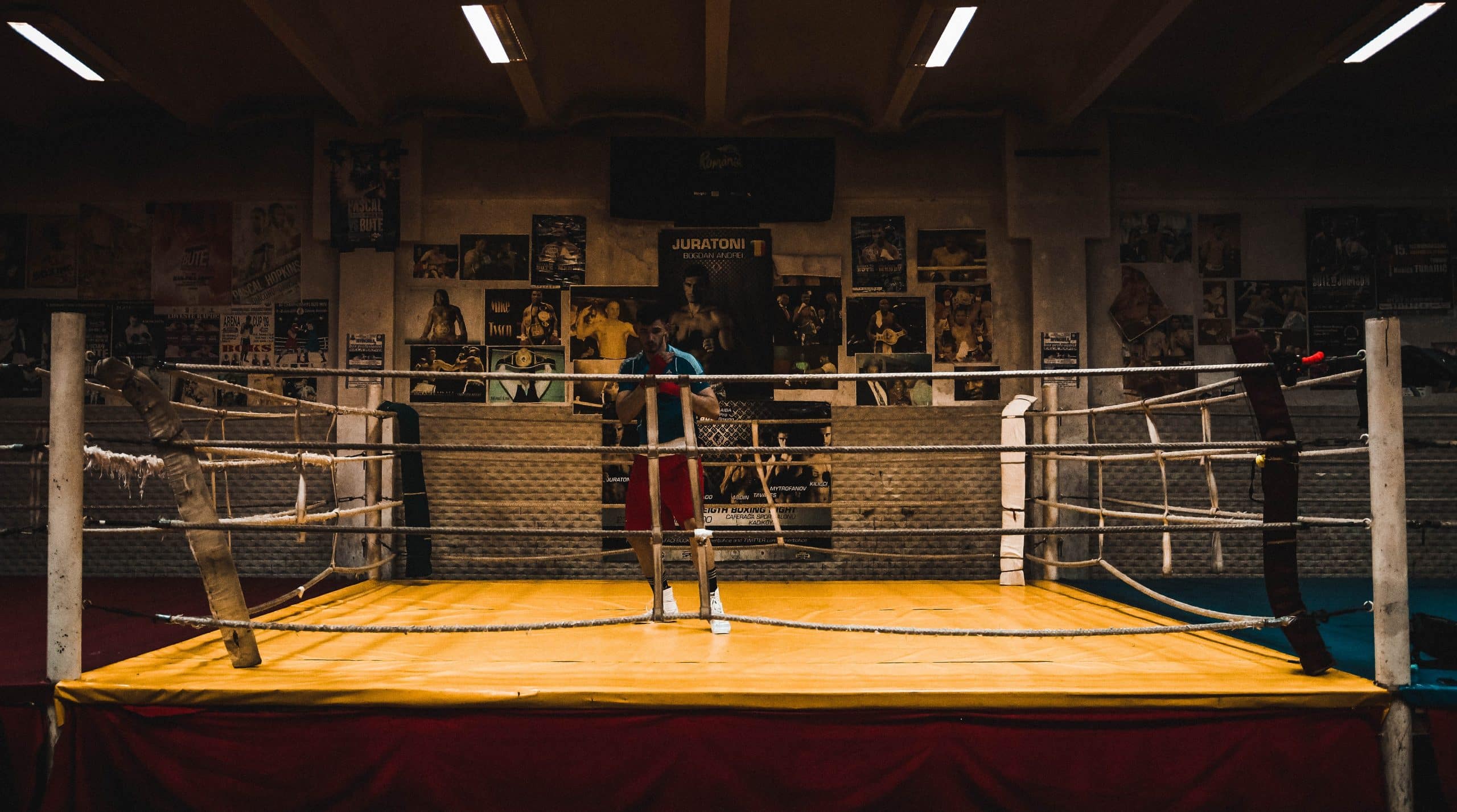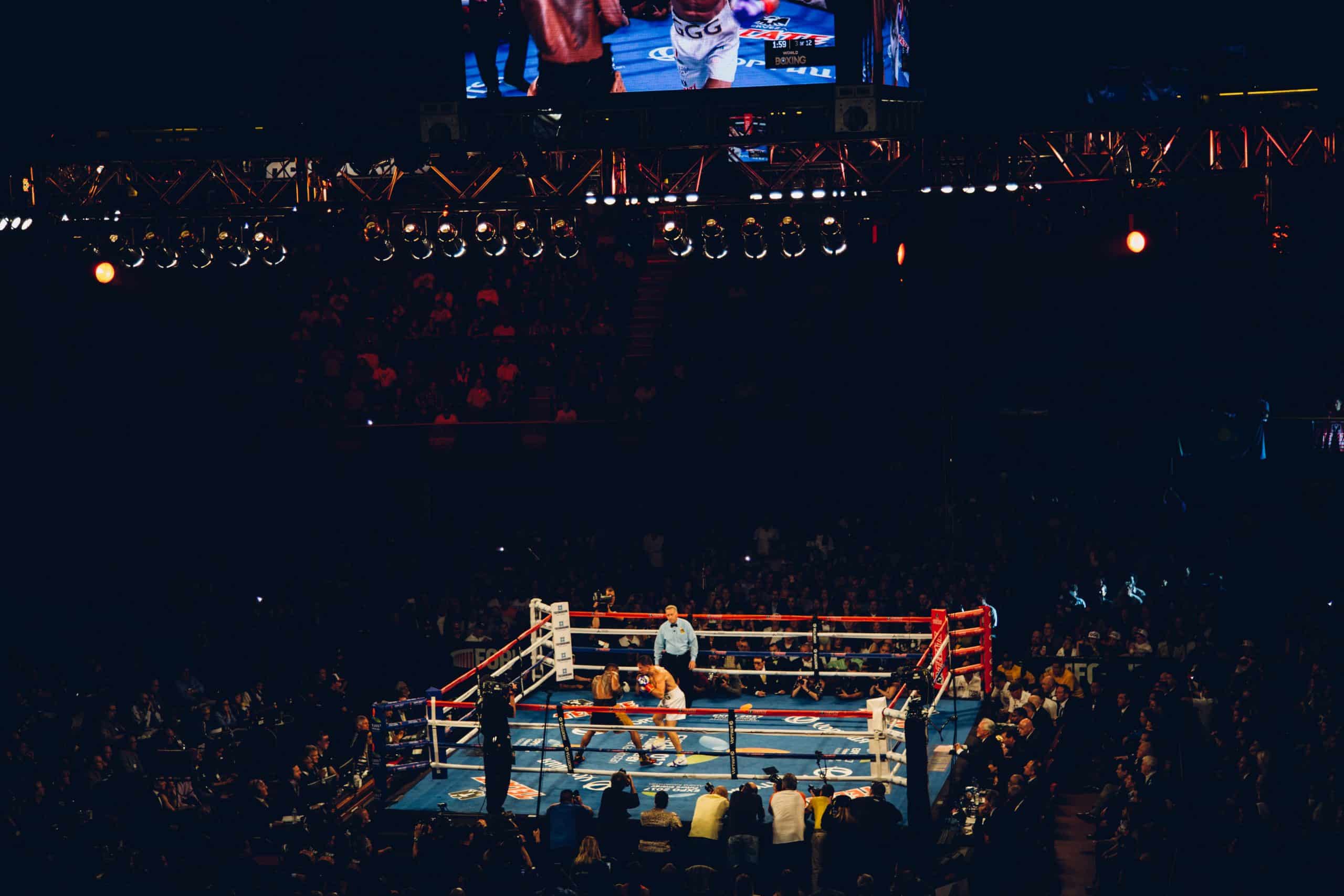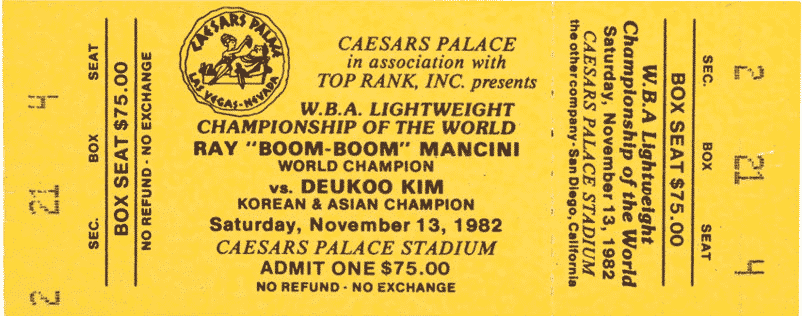Something that I've noticed that there's a lack of online is freely available information on boxing's record-breakers - while there are a few roundup articles on various things, there wasn't much on who has the most wins in boxing. And I'm not just talking the people who won the most - I'm talking the top 3 undefeated fighters in history, the top 3 fighters with the most title defenses, etc.
In this article we break this down - each record, who achieved it, and a little information on the fighter themselves. I've also cited sources best I can, so you'll be able to independently verify this information where it exists elsewhere on the web.
My HUGE thanks to BoxRec for the technical details on each fighter - without this incredible site that’s had a massive input into the sport’s historical accuracy, none of this article would have been possible.
Note: Every boxer's record in this article has been sourced from BoxRec, with the exception of Vince Shomo.
The most wins overall
This is a REALLY difficult metric to quantify. I had to comb through BoxRec and other sources in order to find this information, and in a lot of cases there are “records” that are thrown around but in actuality it’s difficult to verify these records in terms of fights actually fought and what the results were.
I’m continually updating this list with fresh information as and when I get it. The days of boxers having 200 - 300 fights are long since over, and as we’re primarily looking at fighters who were active before 1940, there sometimes don’t exist accurate and complete historical records of fighters from this era.
There are likely other boxers who fit into the number 2 and 3 spot. The below list is the best I could do with the information that’s available on the internet.
If you know of other fighters who fit into this list, please leave a comment below and I will update the article.
Note: Images, where applicable are royalty-free. Where it was not possible to find a royalty-free image, either the Boxing Reviewer logo has been used, or a non-free image has been used under United States fair use doctrine. If you have any questions about our use of images in this website, please contact us.
Len Wickwar
Nationality: United Kingdom
Division: Lightweight
Years active: 1928 - 1947
Record: 340 wins - 87 losses - 43 draws
The first fighter on this list - Len Wickwar was a British fighter born in 1911. He tops the list for both the most wins in professional boxing, as well as the most fights, with 473 verified fights and 4020 rounds fought over his career - mostly at lightweight, but he fought at welterweight in the later part of his career.
Wickwar was never given a title shot in his career - he did beat British lightweight champion Jimmy Walsh in a 1937 non-title fight, and was a contender for the title by 1938 but never got a shot at the champ - Dave Crowley.
Wickwar's career was put on hold by World War II - he did return to boxing after the war in a limited capacity. His final fight was in 1947 at welterweight, where he was knocked out by Danny Cunningham. After his boxing career he worked as a packer and labourer in his local town of Leicester, United Kingdom.
Billy Bird
Nationality: United Kingdom
Division: Welterweight
Years active: 1920 - 1948
Record: 260 wins - 73 losses - 20 draws
Billy Bird was a British welterweight boxer from London born in 1899. Bird also had a huge number of fights - 356 fights, with 260 wins and 73 losses. Incidentally Bird holds the record for the most number of wins by knockout at 138 - which we discuss later in the article.
Bird is regarded as one of the most active boxers of all time. Looking at his record, at some points in his career he was fighting as frequently as once per week. As far as we can ascertain from information available on the internet, he did not challenge for a world title. Incidentally Bird fought Len Wickwar in 1937 - he beat Wickwar on points.
When not boxing Bird worked as a taxi driver. He died in February 1951 at the age of 52.
*Image used under fair use doctrine.
Willie Pep
"Will o' the Wisp"
Nationality: United States of America
Division: Featherweight
Years active: 1940 - 1966
Record: 229 wins - 11 losses - 1 draw
The old Will o' the Wisp - a defensive master and twice world featherweight champion - Willie Pep was born Guglielmo Papaleo in 1922. Currently ranked as one of the pound-for-pound greats and possibly the greatest featherweight of all time, Pep racked up 229 wins (65 by KO) in his 26 year career.
Spending his early career primarily fighting in New England, by 1944 he was world featherweight champion. There is a rumour that Pep won a round against Jackie Graves in 1946 without throwing a punch - although this is disputed, and contemporary sources do not support it.
Pep was severely injured in a plane crash in 1947. Having lost his featherweight belt in 1948 to Sandy Saddler (which he recovered by a 15 round points decision in 1949), he continued to box on and off until 1966 when he officially retired. He did continue fighting exhibition bouts with Sandy Saddler, and served as a referee and boxing inspector. He died in 2006.
The most wins for fighters who retired undefeated
What about the most wins for fighters who never took a loss? There aren't many fighters who have achieved this - notable examples are Joe Calzaghe and Rocky Marciano. In this list we go through the fighters who retired with the most wins. We have not taken into consideration draws and no-contests in this list - only wins and losses.
*Image used under fair use doctrine.
Jimmy Barry
"The Little Tiger"
Nationality: United States of America
Division: Bantamweight
Years active: 1890 - 1899
Record: 59 wins - 0 losses - 10 draws
Jimmy Barry was a US boxer born in 1870 who held the world bantamweight championship between 1894 and 1899, and is possibly the first fighter we have on record to have retired undefeated.
In one of his early fights, Barry knocked out British fighter Jack Levy in 17 rounds to win the world bantamweight championship (although the win was possibly not sanctioned properly in the US.) However, it's historically agreed that his first victorious sanctioned title fight took place in 1894 where he knocked out Jimmy Gorman in 11 rounds.
One of the more tragic events of Barry's career was when he knocked out English champion Walter Croot in London in 1897. Croot never regained consciousness and died with a brain injury the following day. Barry was initially charged with manslaughter but was acquitted when it was determined that Croot had died from a head injury sustained from hitting the wooden floor. This actually led to reform in the boxing industry and the creation of padded ring surfaces.
Barry fought again after this event but never with the same heart, and never scored a knockout again in his career, retiring in 1899. Barry joined the US army in World War I where he worked as a boxing instructor - incidentally the same as Packey McFarland, who we discuss later in the article. Barry died of suspected tuberculosis in 1943.
Ricardo Lopez
"El Finito"
Nationality: Mexico
Division: Minimumweight
Years active: 1985 - 2001
Record: 51 wins - 0 losses - 1 draw
Ricardo Lopez is a Mexican former boxer who was a two weight world champion - at mini flightweight from 1980 to 1998, and at junior flyweight between 1998 and 2001. Lopez also never lost an amateur bout.
His first title break came in 1990 when Lopez defeated Hideyuki Ohashi via a 5th round knockout. Defending his title a number of times in the intervening years, he was stripped of his WBO mini flyweight title when he publicly stated that he wanted to give his belt to his father. Lopez's second stint as world champion begain in 1998 when he defeated Will Grigsby by a unanimous decision.
Lopez announced his retirement in 2002. He now works as a boxing broadcaster for Mexico's Televisa network.
Floyd Mayweather Jr
"Pretty Boy", "Money"
Nationality: United States of America
Division: Welterweight
Years active: 1996 - 2017
Record: 50 wins - 0 losses - 0 draws
Floyd Mayweather Jr is possibly the richest boxer in the world today . Born Floyd Joy Sinclair in 1977, he won 15 major world championships in his career from super featherweight to light middleweight. An olympic bronze medalist and three-time Golden Gloves champion, Mayweather is ranked by BoxRec as the greatest boxer of all time, pound for pound.
Known as a master of defence, Mayweather is also the most accurate puncher since the history of CompuBox, and has the highest plus-minus ratio in recorded boxing history.
Mayweather's first title fight was against Genaro Hernandez in 1998, which he won with an eighth-round technical knockout. Since then Mayweather has won title fights against Emmanuel Augustus, Diego Corrales, Jose Luis Castillo, Oscar de la Hoya, Canelo Alvarez and Manny Pacquiao, among others.
Mayweather came out of retirement in 2017 to fight MMA champion Conor McGregor. He now owns a team in the NASCAR racing series called The Money Team Racing.
The most wins by KO
This one is self-explanatory - these are the top three fighters by number of knockout wins.
Billy Bird
Nationality: United Kingdom
Division: Welterweight
Years active: 1920 - 1948
Record: 260 wins - 73 losses - 20 draws
Wins by KO: 139 (Source)
We've already discussed Billy Bird in the "most wins overall" section of this article - so we won't be revisiting his history. However, he is known for having the most verified wins by KO of any fighter in history at 139.
Archie Moore
"The Old Mongoose"
Nationality: United States of America
Division: Light Heavyweight
Years active: 1935 - 1963
Record: 186 wins - 23 losses - 10 draws
Wins by KO: 132 (Source)
Archie Moore was born in 1913 and is known as the longest reigning world light-heavyweight champion of all time - which he held between 1952 and 1962. He also had one of the longest careers of any fighter, competing for nearly 30 years from 1935 to 1963.
Ranked as the third greatest boxer of all time by BoxRec, Moore is known for his strategy in the ring, with an exceptionally strong chin and defensive ability.
Moore's professional career was characterised by his long wait for a world title shot - in 1946 he had moved up from the middleweight division and had fought the division's top fighters such as Ezzard Charles and Curtis Sheppard. It wasn't until 1952 that Moore got his world title shot at the age of 36 - a fight against Joey Maxim (who had recently defeated Sugar Ray Robinson by TKO). Moore also had two chances at the world heavyweight title - against Rocky Marciano in 1955 and Floyd Patterson in 1956 in a title elimination fight after the belt had been left vacant by Marciano.
After his professional career was over, Moore made a name for himself as a successful character actor in TV and film. He died in San Diego in 1998 at the age of 84.
Young Stribling
"King of the Canebrakes"
Nationality: United States of America
Division: Heavyweight
Years active: 1921 - 1933
Record: 224 wins - 13 losses - 14 draws
Wins by KO: 129 (Source)
Characterised by his short career and tragically short life, Young Stribling was born in Bainbridge, Georgia in 1904. A keen basketball player and accomplished aviator, Stribling went 57 straight fights without a loss in 1927.
During the peak of his career, Stribling would fly his own aeroplane to fights around the country and served as a lieutenant in the air force. By 1926 he had earned over a million dollars as a boxer.
Stribling died in 1933 after a motorcyle accident when he was only 28. He was en route to the hospital to visit his wife after she had given birth to their children when he was struck by a car. Stribling was taken to the same hospital his wife was in, but tragically died soon after.
The longest undefeated streaks
These three fighters have the longest undefeated streaks in the history of the sport - i.e. the most fights between losses, or the most fights up until they had lost. You'll notice it's a lot higher than the previous list of undefeated fighters - and clearly, if some of these fighters had retired a bit earlier, they might be topping the list for most undefeated fights.
Jimmy Wilde
"The Mighty Atom"
Nationality: United Kingdom
Division: Flyweight
Years active: 1911 - 1923
Record: 131 wins - 3 losses - 1 draw
Undefeated Streak - 103 fights (Source)
Often regarded as the greatest British fighter of all time, Wilde was born in 1892 in Wales. Wilde is considered the first official world flyweight champion, a belt he held in 1914 and again from 1916 to 1917.
Wilde officially started boxing professionally in 1911, but it is assumed that he had been fighting professional since at least 1907. Wilde himself claimed that he had had over 800 fights, but this is disputed by boxing analysts. His first official win was on 1st January 1911, when he knocked out Ted Roberts in three rounds. Wilde was accepted into the British army in 1916 (having previously been rejected twice) but never saw active service in World War I.
Wilde's years after retirement were unfortunately characterised by a series of failed business ventures which left him in poverty. Wilde sadly sustained serious injuries from a mugging in 1965 from which he never recovered, and died in 1969.
Packey McFarland
Nationality: United States of America
Division: Lightweight
Years active: 1904 - 1915
Record: 106 wins - 1 loss - 6 draws
Undefeated Streak: 104 fights (Source)
Packey McFarland was an American boxer born in 1888. Despite his excellent record he was never able to secure a world title shot and thus never became a world champion - and is widely considered the best fighter never to be a world champion.
McFarland began his career in 1904, and in 1905 defeated Jimmy Britt who claimed to the world lightweight champion (although this was disputed and the fight was not a title fight.) Notable opponents that McFarland defeated include Jack Britton, Freddie Welsh and Matt Wells. McFarland's last fight was in 1915, where he fought to a draw with Mike Gibbons.
After his retirement in 1915, he worked as a boxing instructor at Camp Zachary Taylor. After the first world war McFarland became a successful businessman - he managed considerable investments, and was the director of two banks. McFarland died in 1936 of a streptococcus infection.
*Licensed under Creative Commons Attribution License 3.0. Source - https://www.youtube.com/watch?v=NJbxzk2SKOM&t=2117
Julio Cesar Chavez
"El Cesar de Boxeo"
Nationality: Mexico
Division: Super Lightweight
Years active: 1980 - 2005
Record: 107 wins - 6 losses - 2 draws
Undefeated Streak: 87 fights (Source)
Possibly one of the greatest fighters ever to have lived, Julio Cesar Chavez was born in 1962 in Mexico. Listed as the world's best boxer pound for pound from 1990 to 1993, Chavez held numerous belts during his career from super featherweight to light welterweight.
Chavez holds the record for the most title defenses (27) and the second most title defenses won by knockout (21). His professional record was 89-0-1 before losing to Frankie Randall in 1994, before which he had gone 87 straight fights without a loss until his draw with Pernell Whittaker in 1993.
Julio Cesar Chavez is the father of current boxer Omar Chavez, and former WBC middleweight champion Julio Cesar Chavez Jr. Chavez is considered to have an exceptionally strong chin, and was renowned particularly for his devastating left hook.
The most wins in amateur boxing
Note: The amateur record has been listed here. I’m well aware these boxers turned pro, and the pro record is what you’ll generally find elsewhere online. I couldn't find any information on the time they were active as an amateur - so I have listed the time they were active as a professional instead.
*Image used under fair use.
Vince Shomo
Nationality: United States of America
Division: Super lightweight
Years active: 1956 - 1968
Record: 651 wins - 4 losses - 0 draws* (Source)
Vince Shomo was a light welterweight boxer born in New York in 1940. Shomo was the recipient of numerous awards, such as placing first in the 1959 Pan-American games and four Golden Gloves titles between 1956 and a 1960.
An extensive amateur career was followed by a very short professional career. Shomo stopped boxing in 1968 and went on to serve as a referee and boxing official. Shomo retired to Stroudsburg, Pennsylvania, where he died in 2020.
*Claimed record. I could not independently verify this source, nor could I independently verify Shomo's amateur record. Shomo died in 2020 so it is not possible to reach out to him directly to verify his amateur record. If anyone reading this knows a source I could investigate to verify this, please comment below.
Donald Curry
"Lone Star Cobra"
Nationality: United States of America
Division: Welterweight
Years active: 1980 - 1997
Amateur Record: 400 wins - 4 losses - 0 draws (Source)
Donald Curry is a former WBC light middleweight champion and welterweight champion. He also challenged for the IBF and lineal middleweight championships in 1990. Curry was trained as an amateur by Wesley Gate Parker in Fort Worth Texas, who also trained Donald's brother, super lightweight champion Bruce Curry.
Curry turned professional in 1980, and won the NABF welterweight championship in 1982. Notable victories for Curry include Marlon Starling, Jun-Suk Hwang, Milton McCrory and Gianfranco Rosi. A feud with Sugar Ray Leonard plagued Curry throughout the latter half of the 1980s, and he retired for the first time in 1991. Curry returned to boxing in 1997 but quickly retired.
Curry's sons revealed that they believe him to have Chronic Traumatic Encephalopathy due to his memory loss and other mental health issues. Curry is now retired but is quite active on Twitter.
*Used under Creative Commons Attribution License 3.0. Українські_боксери_олімпійці_-_Шелестюк,_Усик,_Берінчик_(позаду),_Ломаченко,_Гвоздик.JPG: KuRaGderivative work: Ahonc, CC BY-SA 3.0
Source: https://en.wikipedia.org/wiki/File:Vasyl_Lomachenko_023a.JPG
Vasyl Lomachenko
"Hi-Tech", "No-mas-chenko"
Nationality: Ukraine
Division: Lightweight
Years active: 2013 - 2021
Amateur Record: 396 wins - 1 loss - 0 draws (Source)
One of the most successful amateur boxers of all time, Lomachenko has an amateur record of 396-1, having avenged that loss twice. A three weight world champion and Olympic gold medallist, Lomachenko is known for his exceptional hand speed and incredible defence - earning him the nickname "Hi-Tech".
Lomachenko challenged for a world title in only his second professional fight, which he lost to Orlando Salido. Salido had lost the title for being overweight and the belt was at stake for Lomachenko only. Lomachenko racked up a series of impressive wins against good opposition such as Gary Russell Jr and Guillermo Rigondeaux, until losing again to Teofimo Lopez in 2020.
Lomachenko is currently suspended by the New York State Athletic Commission. He has returned to his native Ukraine to fight in the territorial defence services.
Highest number of wins as a heavyweight champion
This list documents the fighters who completed the most heavyweight title defences. This is not necessarily the most consecutive title defences - indeed, Wladimir Klitschko's title defences are staggered after he lost to Corrie Sanders and regained the title from Sultan Ibragimov.
Joe Louis
"The Brown Bomber"
Nationality: United States of America
Division: Heavyweight
Years active: 1934 - 1951
Record: 66 wins - 3 losses - 0 draws
Successful title defenses: 25
Regarded as one of the most influential heavyweight boxers of all time, Louis had the longest single reign as a heavyweight champion in boxing history. Regarded as the first black person to reach the status of national hero in the US, he was a focal point of anti-German feeling in the US due to his rematch with German boxer Max Schmeling. Louis was also instrumental in the game of golf, being the first black person to appear at a PGA event in 1952.
Louis lost only three times in his 69 fight career - achieving 52 knockouts and holding the world heavyweight championship between 1937 and 1949, he retired but returned shortly after and failed to regain the championship. His career was over for good in 1951 after being knocked out by Rocky Marciano, and Louis never returned to the ring after this.
Unfortunately Louis's life after boxing was characterised by financial problems and drug abuse. Louis died of a cardiac arrest in Las Vegas in 1981, just several hours after his last public appearance at the Larry Holmes - Trevor Berbick heavyweight championship. Due to his service in WWII, Louis was buried at Arlington National Cemetery with full military honours.
*Image used under Creative Commons CC-BY-SA 4.0. Attribution Fuzheado, CC BY-SA 4.0 <https://creativecommons.org/licenses/by-sa/4.0>, via Wikimedia Commons.
Source: https://commons.wikimedia.org/wiki/File:Klitschko-gesf-2018-7931_(cropped).jpg
Wladimir Klitschko
"Dr. Steelhammer"
Nationality: Ukraine
Division: Heavyweight
Years active: 1996 - 2017
Record: 64 wins - 5 losses - 0 draws
Successful title defenses: 23
A strategic and intelligent boxer, Klitschko is considered to be one of the best heavyweight boxers and champions in the history of the sport. Defeating Chris Byrd in 2000 to win the world heavyweight championship, a shock knockout loss to Corrie Sanders in 2003 lost him the title.
After hiring Emmanuel Steward as a trainer in 2004, Klitschko regained his titles after defeating Chris Byrd again and Sultan Ibragimov in 2008. Unifying the belts following a defeat of David Haye in 2011, Klitschko was champion until his 2015 defeat by Anthony Joshua. Another defeat by Tyson Fury led to Klitschko's retirement in 2015.
In 2022 Klitschko joined Ukraine's territorial defense service, along with his brother Vitali who has been the mayor of Kyiv since 2014.
*Used under Creative Commons CC-BY-SA 2.0. Attribution Kingkongphoto & www.celebrity-photos.com from Laurel Maryland, USA, CC BY-SA 2.0 <https://creativecommons.org/licenses/by-sa/2.0>, via Wikimedia Commons
Source: https://commons.wikimedia.org/wiki/File:Larry_Holmes_1996.jpg
Larry Holmes
"The Easton Assassin"
Nationality: United States of America
Division: Heavyweight
Years active: 1973 - 2002
Record: 69 wins - 6 losses - 0 draws
Successful title defenses: 20
Born in 1949 and whose jab is considered one of the best in heavyweight history, Larry Holmes was a WBC heavyweight champion from 1978 to 1983, and the IBF heavyweight champion from 1983 to 1985. He is the only boxer to have ever stopped Muhammad Ali.
Larry Holmes' early career was characterised by convincing wins over excellent opposition, such as Ken Norton (who also beat Muhammad Ali), Gerry Cooney, Tim Witherspoon and Earnie Shavers. Holmes retired after losing his belts to Michael Spinks in 1985, although made several comeback attempts (each unsuccessful, against Mike Tyson, Evander Holyfield, Oliver McCall and Brian Nielsen.)
Holmes' last fight was in 2002 where he defeated the infamous Eric Esch (also known as Butterbean). Since retiring from boxing he has become a successful businessman in his hometown of Easton, and when he retired, employed over 200 people in his various business ventures.
This article is part of our Boxing Info series.










































